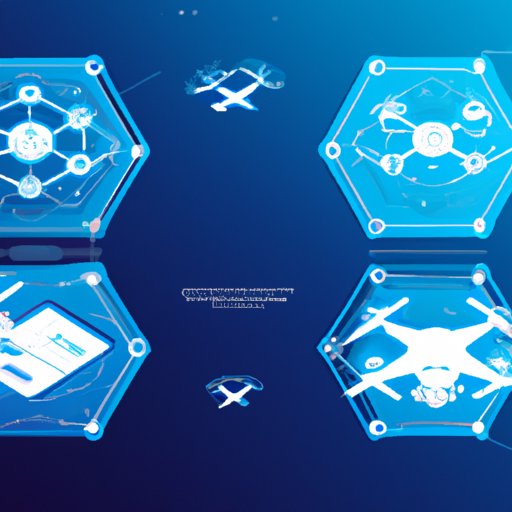Introduction
Drones are becoming increasingly popular for a variety of applications, from photography and video production to delivery services and search and rescue operations. As the demand for more sophisticated drones grows, so too does the need for advanced artificial intelligence (AI) technology. In this article, we will explore the different types of AI used in drones, the benefits and drawbacks of using AI in drone technology, and the impact it has had on the drone industry. We’ll also compare the use of AI in drones to other autonomous technologies, such as autonomous cars and robots.

Exploring the Different Types of AI Used in Drones
The most common types of AI used in drones are machine learning, deep learning, and computer vision. Machine learning is a form of AI that enables computers to learn from data without being explicitly programmed. By analyzing patterns in the data, machines can make decisions and predictions about future events. Deep learning is a subset of machine learning that uses layered neural networks to identify complex patterns in data. Finally, computer vision is a type of AI that enables machines to interpret visual information from cameras or other sensors. This technology is used for object recognition, facial recognition, and navigation.
Examining the Benefits of Using AI in Drone Technology
There are numerous benefits to using AI in drone technology. One of the most significant advantages is improved autonomy. AI-powered drones are able to make decisions independently, meaning that they can respond to changing conditions in real-time without human intervention. This increases the efficiency of drone operations, as well as their safety. AI-powered drones have greater accuracy than manually operated drones, which reduces the risk of accidents or malfunctions.
Drone technology is also becoming more reliable with the use of AI. AI-powered drones can detect and avoid obstacles in their path, making them less likely to crash. They can also recognize certain objects, such as people or animals, and take evasive action if necessary. This makes them safer to operate near populated areas.

Investigating the Potential Drawbacks of Using AI in Drones
Despite the many advantages of using AI in drone technology, there are some potential drawbacks to consider. The cost of implementing AI into drones can be prohibitively expensive, especially for small businesses or individuals. Additionally, AI-powered drones may not be as accurate as humans in certain situations. For example, they may struggle to distinguish between similar objects or to recognize subtle nuances in a scene. Finally, there are security concerns associated with AI-powered drones, as malicious actors could potentially use them to launch attacks or spy on unsuspecting victims.

Analysing the Impact of AI on the Drone Industry
The use of AI in drones has had a profound impact on the drone industry. Businesses have been able to capitalize on the increased efficiency and safety offered by AI-powered drones, leading to greater profits and expanding markets. The regulatory landscape is also shifting, as governments around the world are introducing new laws and regulations to ensure the safe operation of drones. These changes have opened up new opportunities for businesses while also ensuring the safety of the general public.
Comparing the Use of AI in Drones to Other Autonomous Technologies
The use of AI in drones is not unique; autonomous technologies such as self-driving cars and robots are also leveraging the power of AI. Autonomous cars are equipped with sensors and cameras that allow them to ‘see’ the environment and make decisions accordingly. Similarly, robots use AI to perform complex tasks with greater accuracy and speed than humans. Although these technologies differ in application, they all rely on AI to function properly.
Conclusion
In conclusion, AI is playing an increasingly important role in the development of drone technology. AI-powered drones offer numerous benefits, including improved autonomy, increased efficiency, and enhanced safety. However, there are some potential drawbacks to consider, such as cost, accuracy issues, and security concerns. The use of AI in drones has also had a significant impact on the drone industry, creating new opportunities for businesses while also changing the regulatory landscape. Finally, the use of AI in drones is similar to other autonomous technologies, such as autonomous cars and robots.
Overall, the use of AI in drones is a promising development that has the potential to revolutionize the industry. However, further research is needed to address the potential drawbacks and ensure the safe and ethical deployment of AI-powered drones.
(Note: Is this article not meeting your expectations? Do you have knowledge or insights to share? Unlock new opportunities and expand your reach by joining our authors team. Click Registration to join us and share your expertise with our readers.)
